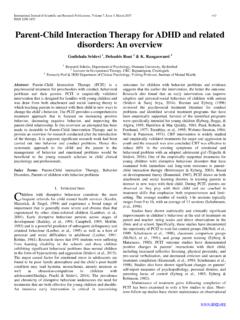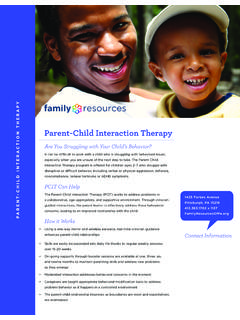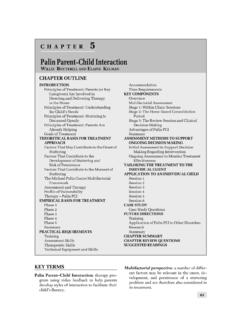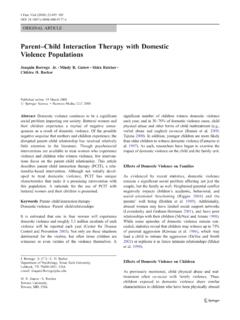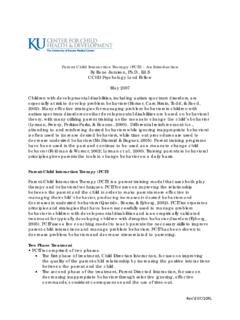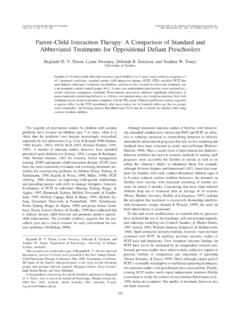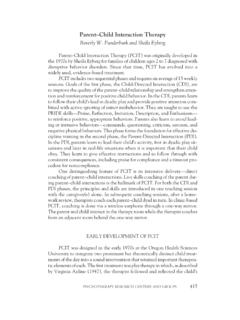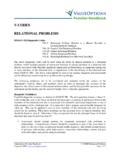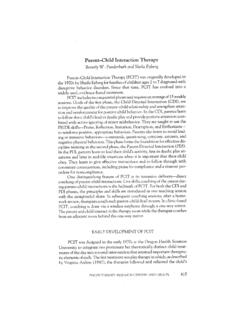Transcription of Parent-Child Interaction Therapy - PCIT
1 UC Davis PCIT Training Center PPPaaarrreeennnttt---CCChhhiiilllddd IIInnnttteeerrraaaccctttiiiooonnn TTThhheeerrraaapppyyy COURSE of TREATMENT MANUAL: PCIT for TRAUMATIZED CHILDREN (PCIT-TC) Version: 3/2013 Attached is an outline and step-by-step process of your PCIT sessions. Behind each section are the forms and handouts you need to successfully complete that session. UC Davis PCIT Training Center 3671 Business Drive, Ste. 100 Sacramento, CA 95820 Anthony Urquiza, (916) 734 7608 PCIT for TRAUMATIZED CHILDREN TTTaaabbbllleee ooofff CCCooonnnttteeennntttsss SECTION 1: GENERAL COURSE OF TRAINING & TREATMENT INFORMATION PCIT Training General Course of PCIT Flow PCIT Flow Chart Selecting the Right SECTION 2: INTAKE INFORMATION Intake Assessment Steps for PCIT Intake.
2 Inclusion & Exclusion Consent to Video Tape PCIT PCIT Assessment Measures What to do with Standardized PCIT Data DPICS Protocol and PCIT Behavioral Observation Priority 15-Minute DPICS Data Recording PCIT Skill Acquisition PCIT child Treatment PCIT Parenting Environmental ECBI Coaching Resources What is PCIT? Handout child Trauma Handout Therapist Engagement Checklist SECTION 3: CDI (RELATIONSHIP ENHANCEMENT) TEACHING INFORMATION Forms for CDI Teaching Session .. Steps for CDI Teaching Session .. PRIDE Skills Ways to Praise! SELECTIVE ATTENTION Toys for HomeFun Rules for Special CDI & PDI Mastery SECTION 4: CDI (RELATIONSHIP ENHANCEMENT) COACHING INFORMATION Forms for CDI Coaching Steps for CDI Coaching 5-Minute CDI Weekly DPICS Data Recording Levels of Resources UC Davis CDI Coaching Grid WACB-P (Weekly Assessment of child Behavior) SECTION 5: MID-TREATMENT ASSESSMENT Forms for Mid-Treatment Steps for Mid-Treatment Assessment of Interaction Skills to Manage SECTION 6: PDI (STRATEGIES TO IMPROVE COMPLIANCE) TEACHING INFORMATION Forms for PDI Teaching Steps for PDI Teaching Steps for Teaching Compliance BE DIRECT Skills PCIT Time Out: PCIT Time Out: Refusal Strategies: Back-Up Room.
3 Swoop & Refusal Strategies: Removal of Two-Choice Removal of SECTION 7: PDI (STRATEGIES TO IMPROVE COMPLIANCE) COACHING INFORMATION Forms for PDI Coaching PDI Coding Instructions for PDI Coding Coding Sheet: 5 minute CDI + 2 minute PDI Coaching for High-Risk Steps for PDI Coaching PDI HomeFun Setting Up House Automatic Time House Steps for Managing Behavior in Managing Difficult Behavior in Resources UC Davis PDI Coaching Grid WACB-N (Weekly Assessment of child Behavior) SECTION 8: PCIT GRADUATION Forms for Graduation Steps for PCIT Graduation Sample Certificate of SECTION 9: PCIT EN ESPA OL Intake en Espa ol DPICS Instructions Espa ECBI Coaching Words Espa Resources Que es PCIT? Handout CDI en Espa ol A Formas de Atenci n Juguetes de Preferencia Tarea Semenal Fortalenciendo la Relaci n Resources WACB-P Espa ol Mid-Treatment en Espa ol Habilidades para Controlar las PDI en Espa ol Ser Tiempo Aparte/Fuera de Dos Recoge e Establecimiento de Reglas para el Como Controlar la Conducta Dificil en Resources WACB-N Espa ol PCIT Trainee Name: _____ PCIT Agency Name:_____ Urquiza, A.
4 , Zebell, N., Timmer, S., & McGrath, J. (2012) Course of Treatment Manual for PCIT-TC. Unpublished Manuscript. PCIT for TRAUMATIZED CHILDREN TRAINING COMPETENCIES FOR CLINICIANS ESSENTIAL COMPONENTS OF PCIT Standardized pre/post treatment measurement ECBI/DPICS Inclusion of CDI and PDI Coding interactions with the DPICS In vivo coaching of the Parent-Child dyad Inclusion of the PRIDE and selective attention/ignoring concepts Use of homework At least 50% of session spent coaching Agency provides appropriate space and equipment, and allows therapists to participate in ongoing training and consultation. MINIMUM REQUIREMENTS FOR BECOMING A PCIT THERAPIST Trainee must: 1) have a master s degree or higher in the mental health field and must be actively working with children and families and 2) be licensed or supervised by a person trained in PCIT.
5 Graduate students enrolled in a master s or doctorate program may participate in training within the context of their overall training program. 40 hours didactic training with role-play (including completion of PCIT-TC web course). Read revised or updated training handouts, training curriculum , PCIT book (McNeil & Hembree-Kigin, second edition, 2010), and selected research articles. Meet PCIT training Competencies for Therapist/Coach (UCDMC CAARE Center, 2000) Administer, score and interpret pre/post measures (ECBI, PSI, CBCL, TSCYC and 15-minute observation with DPICS scoring) Supervision and case consultation through the course of treatment for one PCIT case. Remain current with PCIT research and advancements by attending regional meetings, annual PCIT conferences and other resources ( PCIT Listserve, etc.) Complete two PCIT cases through the full course of treatment.
6 PCIT Trainee Name: _____ PCIT Agency Name:_____ Urquiza, A., Zebell, N., Timmer, S., & McGrath, J. (2012) Course of Treatment Manual for PCIT-TC. Unpublished Manuscript. PHASE II: FUNDAMENTAL AND SKILL-BUILDING Date Approved by Experiential Competency Complete 10 Hour PCIT TC Web Course Evaluation of Web Course Knowledge Meet Mastery Criteria for child -Directed Interaction (CDI) Skills in five-minute role-plays (10 labeled praises, 10 reflections, 10 behavioral descriptions with 3 or less questions, commands, critical statements) Code Parent-Child Interaction using DPICS 3 with 80% accuracy Develop Objectives & Goals using information from clinical interview, pre-measures and behavioral observation Role-Play CDI Teaching Session shows understanding of process Role-Play CDI Coaching Skills shows understanding of process Role-Play PDI Teaching Sessions shows understanding of process Role-Play PDI Coaching Skills shows understanding of process Role-Play Preparing for Graduation describes requirements & considerations for graduation PHASE III: EXPERIENTIAL TRAINING Date Approved by Experiential Competency Intake and Assessment Utilize standardized behavioral measurements (CBCL, ECBI, PSI, TSCYC) in assessment and treatment planning Conduct Structured Behavioral Observations (Dyadic Parent-Child Interaction Coding System.)
7 DPICS) as a component of the assessment process Code 5-minute CDI Parent-Child interactions with 80% accuracy using DPICS (10 times: check off below) child -Directed Interaction Didactic Teach and demonstrate behavioral play Therapy skills (PRIDE) Teach and demonstrate use of selective attention/ignoring Teach and demonstrate avoidance of questions, commands, and critical statements PCIT Trainee Name: _____ PCIT Agency Name:_____ Urquiza, A., Zebell, N., Timmer, S., & McGrath, J. (2012) Course of Treatment Manual for PCIT-TC. Unpublished Manuscript. Explain and provide rationale for completing daily homework Review toys that are appropriate for special play time child -Directed Interaction Coaching Sessions Model CDI Skills during all interactions with parent and child from the outset of contact to termination of session Use ten-minute check-in phase of Therapy to build rapport and briefly review progress/concerns/completion of homework Code parent on PRIDE skills during 5-minute behavioral observation Coach easier-to-master skills ( , description, reflection, imitation) before more difficult skills (labeled praise, avoiding questions & commands)
8 Coach CDI skills by modeling, prompting, and explaining the concepts using all levels of coaching Progress from directive to less directive coaching by praising/reinforcing appropriate parent verbalizations ( give more praise than correction) Effectively coach concepts of ignoring and differential attention Coach qualitative aspects of Parent-Child Interaction ( , physical closeness/affection, eye contact, vocal and facial expression, developmentally sensitive teaching, task persistence, frustration tolerance, sharing, polite manners, and generalization of positive behavior to other settings.) Provide five minutes of positive feedback to parents on their mastery of skills and discuss homework plan Document parent and child progress, strengths, concerns, and track skill mastery on frequency chart Demonstrate ability to structure the opening and closing of sessions so that feedback, homework, and review of child /parent progress occurs Demonstrate ability to teach parent and use Skills to Manage Behavior in coaching sessions.
9 Mid-Treatment Assessment Use five-minute coding sessions to assess readiness for transition to Parent-Directed Interaction phase of treatment Administer standardized measures for re-assessing treatment goals PCIT Trainee Name: _____ PCIT Agency Name:_____ Urquiza, A., Zebell, N., Timmer, S., & McGrath, J. (2012) Course of Treatment Manual for PCIT-TC. Unpublished Manuscript. Develop treatment goals specific for PDI phase of treatment Parent-Directed Interaction Didactic Session Provide rationale for teaching discipline skills to parents and emphasize the importance of continuing to use PRIDE skills Teach and demonstrate rules for giving effective commands (BE DIRECT) Teach and demonstrate importance of praise for compliance (COMMAND-COMPLY-PRAISE) Role-play practice-minding and use of progressively more difficult commands Teach and demonstrate time-out warning and time-out process Teach consistent process for managing time-out refusal Parent-Directed Interaction Coaching Sessions Continue to model CDI Skills during all interactions with parent and child from the outset of contact to termination of session Use ten-minute check-in phase of Therapy to briefly review progress/concerns/completion of homework Code parent on PRIDE skills during 5-minute behavioral observation Coach practice-minding before real life or more challenging commands Code parent on BE DIRECT/Discipline sequence (3/4 commands given directly with correct follow-up sequence.)
10 Progress from directive to less directive coaching by praising/reinforcing appropriate use of PRIDE skills, BE DIRECT skills, and time-out warning and procedures Coach real life directions and develop plan for implementing time-out procedures in other settings Accurately explain the House Rules procedure Accurately explain Behavioral Management/Public Behaviors procedures Provide five minutes of positive feedback to parents on their mastery of skills and discuss plan for carefully selecting necessary commands to practice applying skills at home Document parent and child progress, strengths, concerns, and track maintenance of PRIDE skill mastery on frequency chart PCIT Trainee Name: _____ PCIT Agency Name:_____ Urquiza, A., Zebell, N., Timmer, S., & McGrath, J. (2012) Course of Treatment Manual for PCIT-TC. Unpublished Manuscript. Assess readiness for treatment termination with parent based on level of compliance at home, school, and session, willingness to cooperate with time-out Post-Treatment Assessment Assess need for further Therapy ( , trauma-focused Therapy , social skills group) or adjunct services ( , home-based services, school consultation, medication assessment) Administer 15-minute behavioral assessment to measure parent s achievement of skill acquisition and child s compliance.
